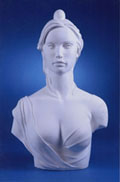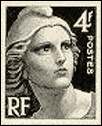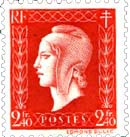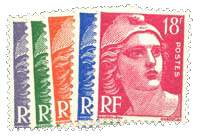
![]()

![]() A
number of female figures have been employed to represent
the French Republic. Two of these are Marianne and Liberty
- they are not the same. Marianne as on the left is usually
young. She wears a
Phrygian cap (or Liberty Cap) and freely displays her
ample charms. Liberty is generally more matronly, more modestly
attired, and wears a crown. But the distinction is not always
clear and one of the most famous representations of Liberty
(by Delacroix) shows her decolloté and wearing a
Liberty cap.
A
number of female figures have been employed to represent
the French Republic. Two of these are Marianne and Liberty
- they are not the same. Marianne as on the left is usually
young. She wears a
Phrygian cap (or Liberty Cap) and freely displays her
ample charms. Liberty is generally more matronly, more modestly
attired, and wears a crown. But the distinction is not always
clear and one of the most famous representations of Liberty
(by Delacroix) shows her decolloté and wearing a
Liberty cap.
Throughout the nineteenth century there were republicans who thought that the Phrygian cap was too revolutionary and that a legalist and peaceful Republic ought to be represented by a different sort of headgear (laurels for example). During this period Republican symbolism acquired some new artistic creations: for example the "Ceres" figure on the first French postage stamp in 1849. Another example is the head on the Légion d'honneur medal.

![]() Undoubtedly,
Marianne is the most famous of the various figures representing
the French Republic, and she generally maintains her
Phrygian cap or Cap of Liberty. She is depicted by the
artist Daumier as a mother nursing two children and by the
sculptor Rude, as an angry warrior singing the Marseillaise
on the Arc de Triomphe. In the last two wars, some people
worshipped her just like a saint. Marianne holds a place
of honour in town halls and law courts, symbolising the
"Triumph of the Republic".
Undoubtedly,
Marianne is the most famous of the various figures representing
the French Republic, and she generally maintains her
Phrygian cap or Cap of Liberty. She is depicted by the
artist Daumier as a mother nursing two children and by the
sculptor Rude, as an angry warrior singing the Marseillaise
on the Arc de Triomphe. In the last two wars, some people
worshipped her just like a saint. Marianne holds a place
of honour in town halls and law courts, symbolising the
"Triumph of the Republic".
 The
origin of the name is uncertain. Some believe the name Marianne
came from that name of the Jesuit Mariana, a 16th century
theoretician, but this is highly improbable. Others believe
her to be based on the wife of the politician Jean Reubell.
According to the story, in 1797 when seeking a name of the
Republic, Barras (one of the members of the Directoire)
during an evening spent at Reubell's house, asked his hostess's
name; "Marie-Anne," she replied. "Perfect,"
The
origin of the name is uncertain. Some believe the name Marianne
came from that name of the Jesuit Mariana, a 16th century
theoretician, but this is highly improbable. Others believe
her to be based on the wife of the politician Jean Reubell.
According to the story, in 1797 when seeking a name of the
Republic, Barras (one of the members of the Directoire)
during an evening spent at Reubell's house, asked his hostess's
name; "Marie-Anne," she replied. "Perfect,"


![]() Barras
exclaimed. "It is a short and simple name which befits
the Republic just as much as yourself, Madame." But
this story is undermined by a recent discovery of a written
mention of the name of Marianne to denote the Republic dating
from October 1792 in Puylaurens in the Tarn department near
Toulouse. At that time local people used to sing a song
in the Provençal language by the poet Guillaume Lavabre
called "La guérison de Marianne" (Marianne's
recovery)
Barras
exclaimed. "It is a short and simple name which befits
the Republic just as much as yourself, Madame." But
this story is undermined by a recent discovery of a written
mention of the name of Marianne to denote the Republic dating
from October 1792 in Puylaurens in the Tarn department near
Toulouse. At that time local people used to sing a song
in the Provençal language by the poet Guillaume Lavabre
called "La guérison de Marianne" (Marianne's
recovery)
Accounts of Revolutionary exploits often contained references to a certain Marie-Anne wearing a Phrygian cap. The name of Marianne also appears to be connected with Republican secret societies. During the Second Empire, one of them, whose members had sworn to overthrow the régime, had taken her name.


![]()
![]()


![]() During
the last thirty years she has taken on the features of Brigitte
Bardot, Catherine Deneuve and those of French fashion models,
Inès de la Fressange and Laeticia Casta.
During
the last thirty years she has taken on the features of Brigitte
Bardot, Catherine Deneuve and those of French fashion models,
Inès de la Fressange and Laeticia Casta.
Marianne is one of the gererally recognised symbols of sovereignty not mentioned in article 2 of the French Constitution of 1958, which refers only to le drapeau tricolore, bleu, blanc, rouge: The French Flag , L'hymne national, the national anthem, The Marseillaise and La devise de la République; the motto . "Liberté, Égalité, Fraternité".
Here are just a few examples used on coins, stamps and public statues.:


![]()
![]()









![]() The
use of Marianne figure wearing a
Phrygian cap is found particularly in municipal institutions.
Recently, a
French logo featuring Marianne has been created for
national public service. Created in 1999, this version
is now on all the stationery, brochures, forms, posters
and information media produced by ministries, prefectures
and embassies. She still wears her
Phrygian cap, but you'd be hard pressed to spot it if
you didn't know exactly what to look for.
The
use of Marianne figure wearing a
Phrygian cap is found particularly in municipal institutions.
Recently, a
French logo featuring Marianne has been created for
national public service. Created in 1999, this version
is now on all the stationery, brochures, forms, posters
and information media produced by ministries, prefectures
and embassies. She still wears her
Phrygian cap, but you'd be hard pressed to spot it if
you didn't know exactly what to look for.





